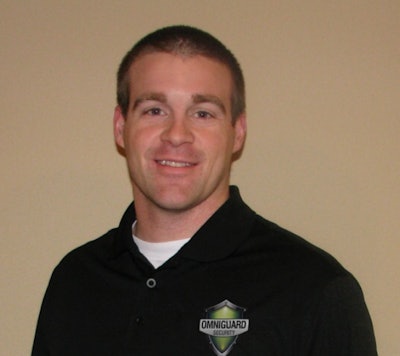
5 questions with CannaGuard Security's Noah Stokes about how security systems can provide a false sense of security (and even put you at risk). Plus, commonly overlooked security issues, and tips for compliance and investing in the right security system.
Running a marijuana dispensary can be fraught with risks, from compliance to the mere fact of selling a product that is still considered illegal by the federal government. But another major concern is surveillance and security: Compliance, again, is a factor here, but theft is a real and present danger. And as Noah Stokes, Founder and CEO of CannaGuard Security, points out, compliance and true security against theft don’t necessarily go hand in hand.
Stokes will be speaking Friday, Sept. 19, on a roundtable featuring cannabis building design and construction experts at the upcoming Cannabusiness Accelerator, a one-day business-to-business conference to be held at the Silver Cloud Hotel Broadway in Seattle. (Cannabis Business Times Editor Noelle Skodzinski also will be speaking on the panel.) Skodzinski talked with Stokes in advance of the roundtable about what dispensary owners need to know about surveillance compliance, and got Stokes’ insights into what they should look for when selecting a security system that meets all state regulations, plus offers real security and the ability to evolve as regulations inevitably change.
Noelle Skodzinski: Can you tell me a bit about your business: When was it founded? How did you get into this business? What services does it provide?
Noah Stokes: Sure. I started my company (OmniGuard Security) in late 2011 and officially launched CannaGuard Security, currently a division of OmniGuard, roughly 4 months ago. I have been in the technology industry for years now and never real thought much about security as an industry because it wasn’t "sexy." Then I started to see new technology hit the market that made these systems easier to use by allowing full control from an easy to use app on my smartphone, and also allowing for the systems to be much more secure at the same time.
We live in a world of a much more educated criminal that we did 10 years ago. With YouTube and blogs a plenty, a mediocre burglar can become … fairly sophisticated …Â in a relatively short amount of time now a days. We as a society, and especially in the Cannabis world, need to stay ahead of these guys.
When I launched my company it was very important to me to create a “product” (my services) that was not only easier to use than what people were getting from the competition, but also to provide my customers with true security, not just false piece of mind. It’s honestly astonishing how easy it is to bypass a standard alarm and security system … scary easy.
Skodzinski: What would you say are a couple of the most important considerations when it comes to security for dispensaries?
Stokes: Anytime that someone is considering a security system, I always tell them, “Don’t be the easiest target on the block!” Don’t use products or companies that put you at risk.
What I mean by that is that if you have an alarm system that runs off a land line phone, all someone has to do is to either cut the line on the outside of the building, pick your door lock (so easy it’s scary … check YouTube if you don’t believe me. Google a "bump key”), unplug the alarm system at the panel, which is in the electrical closet 95 percent of the time, and then destroy or steal the DVR with all the recordings of them doing it.
I can’t tell you how many dispensaries and grow operations I have seen with this style of security system, which is very outdated, but still widely sold to this day, and they think they are protected. The truth is they are not!
Something as simple as the stickers on the outside of your building stating you are “protected by ____” simply let the criminals know what system you have and allow them to Google how to bypass it. The security sign in the yard doesn’t do what it used to depending on what company you use. If anything, it’s more of an advertisement allowing criminals to know what they are getting themselves into.
So a piece of advice is to find a company with a reputation of only doing security systems with the redundancies in place that will not allow for it to be easily bypassed.
The other thing that I can’t stress enough is a system that sends out real-time notifications. Even and especially for non-emergency events, like when the systems has been disarmed after a certain time. It’s not an alarm event, but who and why is my alarm being disarmed at 2am in the morning?
Skodzinski: What are some commonly overlooked security issues you see?
Stokes: There are a few major issues I see. First is that people are too lax with their alarm codes. They don’t realize that on a normal system, once someone has your alarm code all they have to do is to come back late that night, use your alarm code to disarm the alarm and now they can take their time and steal everything. And you’ll never know who did it because they took all your recordings as well, and it was your code that was used.
Another thing is cloud-based redundant video storage for high-value areas. You don’t have to have all your cameras recording in the cloud, but we always sell one or two strictly cloud-based cameras that look at the server, router, safes and areas like the Quarantine rooms. That way, if someone does come in and mess with it, they don’t have access to that video and it can’t be erased for at least seven days.
The last two are video quality and notifications. Make sure that you see what the cameras will look like prior to paying anyone any money. They can promise the world, show you the pictures on the box, but if those cameras can’t be used to identify someone because they are too low quality, then at the end of the day, they are all but worthless from a security standpoint.
The company should be able to show you cameras they have installed that are clear and that you can digitally zoom in on someone and get the clarity you need. We use 5 and 10MP lenses almost exclusively for this reason.
The last are the notifications. My system can give you notifications of just about anything. If someone even looks at the system funny, you can get a text about it! (Not really, but I’m working on it!)
Skodzinski: When it comes to surveillance compliance, what do dispensary owners need to be aware of?
Stokes: The compliance regulations vary greatly by state … and it is extremely important to not only know what the rules say for your state, but what the inspectors are wanting to see. We have found that it is not uncommon for that to be very different. And unfortunately for someone trying to open their business, there isn’t much they can do about it. It’s their way or the highway … no pun intended.
That is why our tagline for CannaGuard is “Beyond Compliance!” We know that a compliant system by no means means that it is secure. People need to understand that when designing their system. You have to pass the inspection yes, but make sure to think about down the road a bit when the building is full and you are up and going. How will your system do at that point?
Most systems cannot expand if the state were to change their requirements … which we all know that they have and will continue to, which can be a big deal if they change it to the point where your current system can’t grow to that much recording space or clarity, and you are forced to rip it out and start over. That is never a fun thing to do.
Skodzinski: How much can new dispensaries expect to spend on a good security and surveillance system?
Stokes: For a dispensary, again it varies by state, but in Oregon a good system should cost around $8k-$12k. The cost can vary quite a bit depending on what they want. I have put in systems in a 1,200-square-foot dispensary that are $6,500, and I have put in systems that are $40k.



























